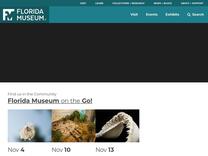Dein Suchergebnis zum Thema: Fu
Video: Town Plans – First Colony Exhibit https://www.floridamuseum.ufl.edu/firstcolony/videos/plans/
Town Plan Herschel Shepard describes Spanish colonial town planning. Plano del Pueblo Herschel Shepard describe el urbanismo colonial español. https://www.youtube.com/watch?v=f9CRs4NyLoI
El Código de Indias fue establecido para dirigir la planificación y San AgustÃn
Caribbean Archaeology Program – Florida Museum of Natural History https://www.floridamuseum.ufl.edu/caribarch/
The Caribbean Archaeology Program was founded in 1960 by Ripley P. Bullen. The program is based around one of the largest systematic collections of pre-Columbian artifacts in North America. What the collection lacks in size is compensated for by its diversity. Contact Us For more informa
Español El Programa en ArqueologÃa Caribeña fue fundado en 1960 por Ripley P
Como Utilizar Este Recurso En-línea – Historical Archaeology https://www.floridamuseum.ufl.edu/histarch/coleccion-digital-de-tipologias/como-utilizar/
Para navegar [BROWSE] entre los tipos cerámicos específicos, o navegar por grupos de tipos cerámicos, procedentes del periodo historico, y aprender sobre ellos Vaya a la página “Lista Tipológica” y seleccione el tipo que le interesa. Al hacer „clic“ recibira una serie de pequeñas imágenes de todos
Forma del Recipiente: [VESSEL FORM] La forma del recipiente del que el fragmento fue
Información sobre la Colección Tipológica – Historical Archaeology https://www.floridamuseum.ufl.edu/histarch/coleccion-digital-de-tipologias/sobre-la-coleccion/
La Colección Tipológica de Cerámicas, localizada en el Laboratorio de Arqueología Histórica del Florida Museum of Natural History, tiene tres componentes principales: las Colecciones de Tipología Histórico-Arqueológicas (Historical Archaeology Type Collections-HTC), la Colección Lister (LC), y la Co
Sin lugar a dudas, el resultado más importante de su labor realizada fue el desarrollo
Ominosa interpretación de la piedra del calendario Azteca – Research News https://www.floridamuseum.ufl.edu/science/ominosa-interpretacion-de-la-piedra-del-calendario-azteca/
Un nuevo estudio de una de los más importantes artefactos restantes del imperio azteca, una piedra calendario de 24 toneladas, interpreta la imagen central de la piedra como la muerte del dios sol Tonatiuh durante un eclipse, un evento que los aztecas creían llevaría a un apocalipsis global acompaña
La piedra, la cual fue exhibida en la plaza principal de la capital azteca, Tenochtitlan
Herbarium Library – University of Florida Herbarium (FLAS) https://www.floridamuseum.ufl.edu/herbarium/collections/library/
The University of Florida Herbarium maintains a non-circulating reference library of publications pertinent to the naming and classification of vascular plants (plant taxonomy and nomenclature). The literature in this collection contains descriptions, geographical ranges and keys for differentiatin
Eustichiaceae FA2 Fabroniaceae FI7 Fissidentaceae FO4 Fontinalaceae FO6 Fontinaliaceae FU6
Christopher Columbus – Caribbean Archaeology Program https://www.floridamuseum.ufl.edu/caribarch/education/columbus/
Christopher Columbus. Admiral of the Ocean Sea. The Great Navigator. Renown as the champion of the belief that the earth was round. The man who sought the riches of the Far East by sailing to the west, and who happened instead upon a New World. The man who discovered America. How accurate is the po
Esta fuerza bélica fue un elemento clave en la conquista de las Américas.

